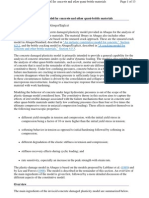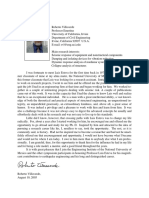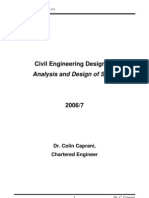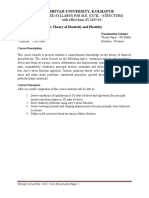Design of Concrete Structures Whit Eurocode 2
Uploaded by
margitorsiDesign of Concrete Structures Whit Eurocode 2
Uploaded by
margitorsiPage 1 of 234
Page 2 of 234
Page 3 of 234
Page 4 of 234
Page 5 of 234
Page 6 of 234
Page 7 of 234
Page 8 of 234
Page 9 of 234
Page 10 of 234
Page 11 of 234
Page 12 of 234
Page 13 of 234
Page 14 of 234
Page 15 of 234
Page 16 of 234
Page 17 of 234
Page 18 of 234
Page 19 of 234
Page 20 of 234
Page 21 of 234
Page 22 of 234
Page 23 of 234
Page 24 of 234
Page 25 of 234
Page 26 of 234
Page 27 of 234
Page 28 of 234
Page 29 of 234
Page 30 of 234
Page 31 of 234
Page 32 of 234
Page 33 of 234
Page 34 of 234
Page 35 of 234
Page 36 of 234
Page 37 of 234
Page 38 of 234
Page 39 of 234
DESIGNERS' GUIDE TO E N 1992- 1 - 1 AND E N 1992- 1-2
Fig. 3-3.Application of the effective geometrical imperfections: unbraced structure (number of
vertically continuous members = 3 )
Fig. 3,4. Minimum tie force for perimeter columns
forces should be taken into account in the stability calculation. This is in addition to other
design horizontal actions, such as wind.
3.3.3. Design of slender elements
In the design of slender elements, which are prone to fail by buckling (e.g. slender columns),
EN 1992-1-1 requires geometrical imperfection to be added to other eccentricities. For
example, in the design of the columns, an eccentricity of 0,1,/2 is assumed for geometrical
imperfection (where 1, is the effective length of the column).
3.3.4. Members transferring forces to bracing elements
In the design of these elements (such as a floor diagram), a force to account for the possible
imperfection should be taken into account in addition to other design actions. This
additional force is illustrated in Fig. 3.4. This force need not be taken into account in the
design of the bracing element itself.
Cjause 5.8.2(6)
As structures subject to lateral loads deflect, the vertical loads acting on the structure
produce additional forces and moments. These are normally referred to as second-order
effects. Consider a cantilever column shown in Fig. 3.5. The deflection caused by the
horizontal load alone is A,. In this deflected state, the vertical loadPwill contribute a further
bending moment and increase the lateral sway, and the final deflection will be A,. This
phenomenon is also commonly referred to as the 'PA effect'.
E N 1992-1-1 requires second-order effects to be considered where they may significantly
affect the stability of the structure as a whole or the attainment of the ultimate limit state at
critical sections.
In the Application Rules, the code further states that for normal buildings, second-order
effects may be neglected if the bending moments caused by them do not increase the first-
Page 40 of 234
Page 41 of 234
Page 42 of 234
Page 43 of 234
Page 44 of 234
Page 45 of 234
Page 46 of 234
Page 47 of 234
Page 48 of 234
Page 49 of 234
Page 50 of 234
Page 51 of 234
Page 52 of 234
Page 53 of 234
Page 54 of 234
Page 55 of 234
Page 56 of 234
Page 57 of 234
Page 58 of 234
Page 59 of 234
Page 60 of 234
Page 61 of 234
Page 62 of 234
Page 63 of 234
Page 64 of 234
Page 65 of 234
Page 66 of 234
Page 67 of 234
Page 68 of 234
Page 69 of 234
Page 70 of 234
Page 71 of 234
Page 72 of 234
Page 73 of 234
Page 74 of 234
Page 75 of 234
Page 76 of 234
Page 77 of 234
Page 78 of 234
Page 79 of 234
Page 80 of 234
Page 81 of 234
Page 82 of 234
Page 83 of 234
Page 84 of 234
Page 85 of 234
Page 86 of 234
Page 87 of 234
Page 88 of 234
Page 89 of 234
Page 90 of 234
Page 91 of 234
Page 92 of 234
Page 93 of 234
Page 94 of 234
Page 95 of 234
Page 96 of 234
Page 97 of 234
Page 98 of 234
Page 99 of 234
Page 100 of 234
Page 101 of 234
Page 102 of 234
Page 103 of 234
Page 104 of 234
Page 105 of 234
Page 106 of 234
Page 107 of 234
Page 108 of 234
Page 109 of 234
Page 110 of 234
Page 111 of 234
Page 112 of 234
Page 113 of 234
Page 114 of 234
Page 115 of 234
Page 116 of 234
Page 117 of 234
Page 118 of 234
Page 119 of 234
Page 120 of 234
Page 121 of 234
Page 122 of 234
Page 123 of 234
Page 124 of 234
Page 125 of 234
Page 126 of 234
Page 127 of 234
Page 128 of 234
Page 129 of 234
Page 130 of 234
Page 131 of 234
Page 132 of 234
Page 133 of 234
Page 134 of 234
Page 135 of 234
Page 136 of 234
Page 137 of 234
Page 138 of 234
Page 139 of 234
Page 140 of 234
Page 141 of 234
Page 142 of 234
Page 143 of 234
Page 144 of 234
Page 145 of 234
Page 146 of 234
Page 147 of 234
Page 148 of 234
Page 149 of 234
Page 150 of 234
Page 151 of 234
Page 152 of 234
Page 153 of 234
Page 154 of 234
Page 155 of 234
Page 156 of 234
Page 157 of 234
Page 158 of 234
Page 159 of 234
Page 160 of 234
Page 161 of 234
Page 162 of 234
Page 163 of 234
Page 164 of 234
Page 165 of 234
Page 166 of 234
Page 167 of 234
Page 168 of 234
Page 169 of 234
Page 170 of 234
Page 171 of 234
Page 172 of 234
Page 173 of 234
Page 174 of 234
Page 175 of 234
Page 176 of 234
Page 177 of 234
Page 178 of 234
Page 179 of 234
Page 180 of 234
Page 181 of 234
Page 182 of 234
Page 183 of 234
Page 184 of 234
Page 185 of 234
Page 186 of 234
Page 187 of 234
Page 188 of 234
Page 189 of 234
Page 190 of 234
Page 191 of 234
Page 192 of 234
Page 193 of 234
Page 194 of 234
Page 195 of 234
Page 196 of 234
Page 197 of 234
Page 198 of 234
Page 199 of 234
Page 200 of 234
Page 201 of 234
Page 202 of 234
Page 203 of 234
Page 204 of 234
Page 205 of 234
Page 206 of 234
Page 207 of 234
Page 208 of 234
Page 209 of 234
Page 210 of 234
Page 211 of 234
Page 212 of 234
Page 213 of 234
Page 214 of 234
Page 215 of 234
Page 216 of 234
Page 217 of 234
Page 218 of 234
Page 219 of 234
Page 220 of 234
Page 221 of 234
Page 222 of 234
Page 223 of 234
Page 224 of 234
Page 225 of 234
Page 226 of 234
Page 227 of 234
Page 228 of 234
Page 229 of 234
Page 230 of 234
Page 231 of 234
Page 232 of 234
Page 233 of 234
Page 234 of 234
You might also like
- The Analysis of Irregular Shaped Structures: Wood Diaphragms and Shear Walls, Second EditionFrom EverandThe Analysis of Irregular Shaped Structures: Wood Diaphragms and Shear Walls, Second EditionNo ratings yet
- Ohtori - Spencer - MATLAB Based Tool For Nonlinear Structural AnalysisNo ratings yetOhtori - Spencer - MATLAB Based Tool For Nonlinear Structural Analysis6 pages
- State of Art (SOTA) For Ph.D. Research Work On: Vibration Behaviour of Beam and Plate Under Moving LoadNo ratings yetState of Art (SOTA) For Ph.D. Research Work On: Vibration Behaviour of Beam and Plate Under Moving Load44 pages
- Methodologies To Mitigate Wind-Induced Vibration of Tall Buildings100% (1)Methodologies To Mitigate Wind-Induced Vibration of Tall Buildings25 pages
- DSS Lecture Note 4 - Lateral Loads - Seismic LoadNo ratings yetDSS Lecture Note 4 - Lateral Loads - Seismic Load25 pages
- 1714 Deep Beams Concept Applications Assumptions A Differences Between Deep A Simple Beams0% (2)1714 Deep Beams Concept Applications Assumptions A Differences Between Deep A Simple Beams3 pages
- Structural Analysis 7 Edition in SI Units: Displacement Method of Analysis: Moment DistributionNo ratings yetStructural Analysis 7 Edition in SI Units: Displacement Method of Analysis: Moment Distribution47 pages
- Performance-Based Design in Earthquake Engineering: A Multidisciplinary ReviewNo ratings yetPerformance-Based Design in Earthquake Engineering: A Multidisciplinary Review19 pages
- Seismic Design of Bridges - Equivalent Cantilever MethodNo ratings yetSeismic Design of Bridges - Equivalent Cantilever Method14 pages
- Civil Engineering Design (1) : Analysis and Design of Slabs83% (6)Civil Engineering Design (1) : Analysis and Design of Slabs40 pages
- Footing Soil Pressure From Biaxial LoadingNo ratings yetFooting Soil Pressure From Biaxial Loading18 pages
- Nonlinear Analysis of Membrane Elements by Fixed-Angle Softened-Truss ModelNo ratings yetNonlinear Analysis of Membrane Elements by Fixed-Angle Softened-Truss Model9 pages
- Shear, Bond, Anchorage, Development Length and Torsion: Version 2 CE IIT, KharagpurNo ratings yetShear, Bond, Anchorage, Development Length and Torsion: Version 2 CE IIT, Kharagpur19 pages
- ME Structures Theory Elasticity PlasticityNo ratings yetME Structures Theory Elasticity Plasticity3 pages
- Learning Earthquake Design & ConstructionNo ratings yetLearning Earthquake Design & Construction55 pages
- Sap 2000 Verification. Simply Supported Beam On Elastic Foundation100% (1)Sap 2000 Verification. Simply Supported Beam On Elastic Foundation4 pages
- Reinforced Concrete Design, 7th Edition - Sample Pages100% (3)Reinforced Concrete Design, 7th Edition - Sample Pages10 pages
- fib Model Code for Concrete Structures 2010From Everandfib Model Code for Concrete Structures 20101/5 (1)
- A Catalogue of Details on Pre-Contract Schedules: Surgical Eye Centre of Excellence - KathFrom EverandA Catalogue of Details on Pre-Contract Schedules: Surgical Eye Centre of Excellence - KathNo ratings yet
- Structural Engineering DocumentsFrom EverandStructural Engineering DocumentsJorge de BritoNo ratings yet
- Civil Engineering Structures According to the Eurocodes: Inspection and MaintenanceFrom EverandCivil Engineering Structures According to the Eurocodes: Inspection and MaintenanceNo ratings yet
- Probabilistic service life model of RC structures subjected to the combined effect of chloride-induced corrosion and cyclic loadingFrom EverandProbabilistic service life model of RC structures subjected to the combined effect of chloride-induced corrosion and cyclic loadingNo ratings yet
- Plates and Shells for Smart Structures: Classical and Advanced Theories for Modeling and AnalysisFrom EverandPlates and Shells for Smart Structures: Classical and Advanced Theories for Modeling and Analysis5/5 (1)
- Elasticity and Plasticity: The Mathematical Theory of Elasticity and The Mathematical Theory of PlasticityFrom EverandElasticity and Plasticity: The Mathematical Theory of Elasticity and The Mathematical Theory of PlasticityNo ratings yet
- Geotechnical Aspects of Building Design (EN 1997) : Eurocode 2No ratings yetGeotechnical Aspects of Building Design (EN 1997) : Eurocode 255 pages
- Three Dimensional Static and Dynamic Analysis of Structures100% (1)Three Dimensional Static and Dynamic Analysis of Structures423 pages
- Information and Pool Sap2000 Manuals English Problem 6 005No ratings yetInformation and Pool Sap2000 Manuals English Problem 6 0058 pages
- Di Mentioning A Simplex Swirl Injector JournalNo ratings yetDi Mentioning A Simplex Swirl Injector Journal15 pages
- Chapter 22: Current and Resistance: SolutionsNo ratings yetChapter 22: Current and Resistance: Solutions5 pages
- Torah and Mathematics Hamaor Pesach 5780 2020 pp48-57No ratings yetTorah and Mathematics Hamaor Pesach 5780 2020 pp48-5710 pages
- INTERNATIONAL BEST PRACTICE Delivering Outcomes - The Abu Dhabi Lighting Manual - A World Leading Specification For Advanced Performance Trevor Leighton PDFNo ratings yetINTERNATIONAL BEST PRACTICE Delivering Outcomes - The Abu Dhabi Lighting Manual - A World Leading Specification For Advanced Performance Trevor Leighton PDF29 pages
- dynamic_correspondence_of_resistance_training_to.7No ratings yetdynamic_correspondence_of_resistance_training_to.79 pages
- Module 1 - Introduction To Numerical Methods PDFNo ratings yetModule 1 - Introduction To Numerical Methods PDF20 pages
- Frequently Used Equations - The Physics HypertextbookNo ratings yetFrequently Used Equations - The Physics Hypertextbook4 pages
- The Analysis of Irregular Shaped Structures: Wood Diaphragms and Shear Walls, Second EditionFrom EverandThe Analysis of Irregular Shaped Structures: Wood Diaphragms and Shear Walls, Second Edition
- Ohtori - Spencer - MATLAB Based Tool For Nonlinear Structural AnalysisOhtori - Spencer - MATLAB Based Tool For Nonlinear Structural Analysis
- State of Art (SOTA) For Ph.D. Research Work On: Vibration Behaviour of Beam and Plate Under Moving LoadState of Art (SOTA) For Ph.D. Research Work On: Vibration Behaviour of Beam and Plate Under Moving Load
- Methodologies To Mitigate Wind-Induced Vibration of Tall BuildingsMethodologies To Mitigate Wind-Induced Vibration of Tall Buildings
- 1714 Deep Beams Concept Applications Assumptions A Differences Between Deep A Simple Beams1714 Deep Beams Concept Applications Assumptions A Differences Between Deep A Simple Beams
- Structural Analysis 7 Edition in SI Units: Displacement Method of Analysis: Moment DistributionStructural Analysis 7 Edition in SI Units: Displacement Method of Analysis: Moment Distribution
- Performance-Based Design in Earthquake Engineering: A Multidisciplinary ReviewPerformance-Based Design in Earthquake Engineering: A Multidisciplinary Review
- Seismic Design of Bridges - Equivalent Cantilever MethodSeismic Design of Bridges - Equivalent Cantilever Method
- Civil Engineering Design (1) : Analysis and Design of SlabsCivil Engineering Design (1) : Analysis and Design of Slabs
- Nonlinear Analysis of Membrane Elements by Fixed-Angle Softened-Truss ModelNonlinear Analysis of Membrane Elements by Fixed-Angle Softened-Truss Model
- Shear, Bond, Anchorage, Development Length and Torsion: Version 2 CE IIT, KharagpurShear, Bond, Anchorage, Development Length and Torsion: Version 2 CE IIT, Kharagpur
- Sap 2000 Verification. Simply Supported Beam On Elastic FoundationSap 2000 Verification. Simply Supported Beam On Elastic Foundation
- Reinforced Concrete Design, 7th Edition - Sample PagesReinforced Concrete Design, 7th Edition - Sample Pages
- A Catalogue of Details on Pre-Contract Schedules: Surgical Eye Centre of Excellence - KathFrom EverandA Catalogue of Details on Pre-Contract Schedules: Surgical Eye Centre of Excellence - Kath
- Civil Engineering Structures According to the Eurocodes: Inspection and MaintenanceFrom EverandCivil Engineering Structures According to the Eurocodes: Inspection and Maintenance
- Discrete Element Method to Model 3D Continuous MaterialsFrom EverandDiscrete Element Method to Model 3D Continuous Materials
- Probabilistic service life model of RC structures subjected to the combined effect of chloride-induced corrosion and cyclic loadingFrom EverandProbabilistic service life model of RC structures subjected to the combined effect of chloride-induced corrosion and cyclic loading
- Plates and Shells for Smart Structures: Classical and Advanced Theories for Modeling and AnalysisFrom EverandPlates and Shells for Smart Structures: Classical and Advanced Theories for Modeling and Analysis
- Elasticity and Plasticity: The Mathematical Theory of Elasticity and The Mathematical Theory of PlasticityFrom EverandElasticity and Plasticity: The Mathematical Theory of Elasticity and The Mathematical Theory of Plasticity
- Geotechnical Aspects of Building Design (EN 1997) : Eurocode 2Geotechnical Aspects of Building Design (EN 1997) : Eurocode 2
- Three Dimensional Static and Dynamic Analysis of StructuresThree Dimensional Static and Dynamic Analysis of Structures
- Information and Pool Sap2000 Manuals English Problem 6 005Information and Pool Sap2000 Manuals English Problem 6 005
- Torah and Mathematics Hamaor Pesach 5780 2020 pp48-57Torah and Mathematics Hamaor Pesach 5780 2020 pp48-57
- INTERNATIONAL BEST PRACTICE Delivering Outcomes - The Abu Dhabi Lighting Manual - A World Leading Specification For Advanced Performance Trevor Leighton PDFINTERNATIONAL BEST PRACTICE Delivering Outcomes - The Abu Dhabi Lighting Manual - A World Leading Specification For Advanced Performance Trevor Leighton PDF
- dynamic_correspondence_of_resistance_training_to.7dynamic_correspondence_of_resistance_training_to.7
- Frequently Used Equations - The Physics HypertextbookFrequently Used Equations - The Physics Hypertextbook








































































































